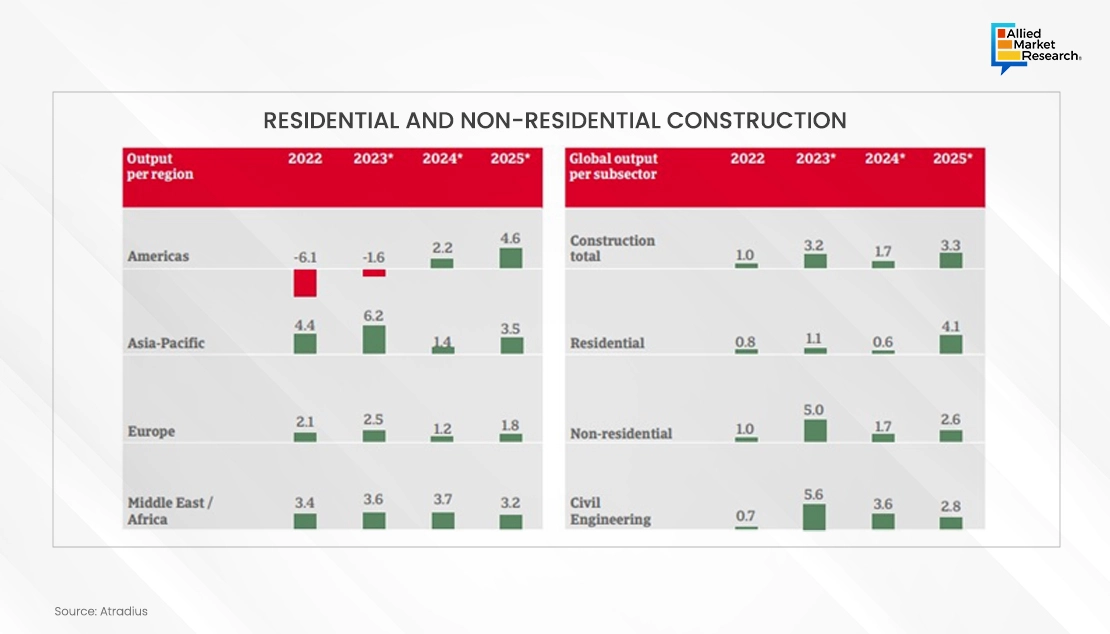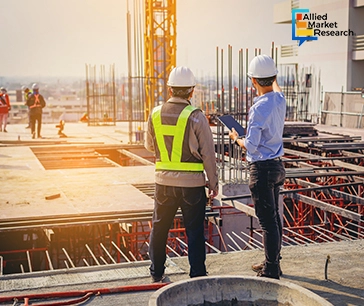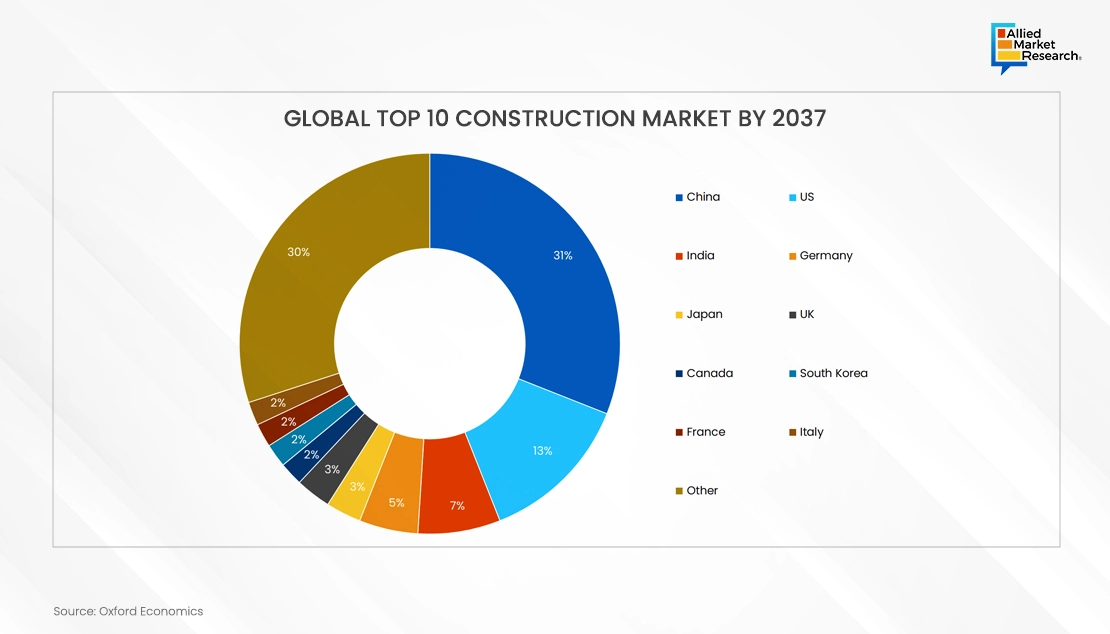Table Of Contents
- Navigating the 2023 Construction Landscape: Insights and Projections
- Residential and Non-residential Construction
- Regional Insights on the Construction Industry in 2023
- Regional Outlook for 2024
- Construction
- Manufacturing
- The Future Scope of the Construction and Manufacturing Industry
- Construction
- Manufacturing
- The Bottom Line

Sonia Mutreja

Pooja Parvatkar
Construction and Manufacturing 2023: A Year of Resilience and Innovation

On the manufacturing front, the industry capitalized on the momentum from these legislative pieces, driving significant investments in semiconductors, clean energy, and infrastructure, which nearly doubled those in 2021 and marked a substantial increase from 2019. For instance, investments totaling $88 billion have been announced post-IRA in the US, with the aim of creating over 75,000 jobs. This underscores a firm dedication to revitalizing domestic manufacturing and promoting sustainability. Nonetheless, despite the positive outlook, the manufacturing sector contended with economic uncertainties, skill shortages, and the pressing need for innovation to meet net-zero emissions goals. Yet, the push towards digital transformation, smart factories, and generative AI offered pathways to overcome these hurdles, highlighting an industry on the brink of technological revolution. The year 2023 stands as a testament to the resilience and adaptability of these sectors, setting a precedent for future developments in the face of ongoing and emerging challenges.
Navigating the 2023 Construction Landscape: Insights and Projections
As we navigate through the evolving landscape of the construction industry, a nuanced picture emerges for the year 2023. The dynamics within the residential sector hint at a deceleration in growth. However, this trend is expected to be counterbalanced by promising developments in the non-residential and civil engineering sectors. These areas are poised to benefit significantly from a resurgence in both public and private investments, focusing on infrastructure and commercial ventures.
Residential and Non-residential Construction
Drawing on insights from Atradius N.V., the resilience of the residential construction sector is noteworthy, marking a growth of 1.1% in 2023. Despite this progress, projections suggest a slight slowdown in 2024. On the brighter side, the non-residential construction sector, which includes commercial, industrial, and institutional buildings, has shown a robust recovery and is projected to see a growth spurt of 5% in 2023, with a steady increase of 2.6% by 2025. Civil engineering, the cornerstone of infrastructure development, has witnessed a remarkable 5.6% growth in 2023. This surge is a clear indicator of substantial investments funneling into public works and large-scale projects, with growth expected to moderate to 3.6% in 2024 and 2.8% in 2025.

Regional Insights on the Construction Industry in 2023
The global perspective offers a kaleidoscope of growth trajectories. America is making a noteworthy rebound from the sharp declines experienced in previous years. Meanwhile, the Asia-Pacific region continues to assert its dominance as a growth engine, and Europe charts a course of steady progress amid various market challenges. The sustained growth in the Middle East and Africa underscores the pivotal role of infrastructure and construction in driving economic diversification and growth. After a modest setback in 2023, America is gearing up for an optimistic growth forecast of 2.2% in 2024 and an impressive 4.6% in 2025. The Asia-Pacific region's growth narrative remains compelling, with a 6.2% increase in 2023 and an anticipated stabilization at 3.5% by 2025. Europe's growth is characterized by consistency, with a 2.5% increase in 2023 and an expected gentle tapering to 1.8% over the next two years. The Middle East and Africa, maintaining a solid performance, registered a 3.6% growth in 2023, with projections pointing to a steady pace into 2025.
Looking ahead, the construction industry's path to recovery and expansion is poised to be marked by regional and sectoral disparities. Yet, the overarching narrative leans towards optimism, supported by strategic investments and the gradual stabilization of the global economic landscape.
The global manufacturing landscape of 2023 presents a complex picture, marked by both challenges and opportunities. The Eurozone's manufacturing sector experienced persistent contraction, marking its 18th month of downturn in December, while Asia's manufacturing giants grappled with the repercussions of China's uneven economic revival. This situation stood in sharp contrast to the fleeting optimism that had flickered in financial markets just weeks prior.
In the Eurozone, the manufacturing Purchasing Managers’ Index (PMI) inched up slightly to 44.4 in December from 44.2 in November, underscoring a continuing shrinkage in the sector. Germany, Europe's manufacturing heartland, saw a decline in activity that weighed heavily on the eurozone's GDP, pushing it closer to a with a third consecutive quarter of contraction.
Despite this gloomy backdrop, the year's end hinted at emerging bright spots, particularly in the Asia-Pacific (APAC) region. A nascent recovery in manufacturing output and exports began to unfold, spurred on by a rebound in electronics exports and the dynamic growth in the production and exportation of electric vehicles (EVs). China, in a notable turnaround, registered a slight increase in exports in November—the first rise since April—accompanied by a modest improvement in its PMI, signaling a cautious but positive shift in manufacturing conditions. South Korea, Singapore, Taiwan, and India all reported encouraging signs of recovery and growth in various sectors, from semiconductors to capital goods, highlighting a regional resurgence in manufacturing vitality.
Regional Outlook for 2024
As we peer into 2024, the APAC region stands on the cusp of further expansion within its manufacturing sector, driven by strong domestic demand, especially in the electronics field. The medium-term outlook appears promising, fueled by the expected demand surge related to the rollout of 5G technology, the burgeoning impact of artificial intelligence, and the strides in industrial automation. Additionally, the region's commitment to the electric vehicle market, backed by significant investments in EV assembly and battery production, alongside the potential boost from regional trade agreements such as the RCEP and CPTPP, promises to invigorate intra-APAC trade in a variety of goods.
In conclusion, although 2023 brought its share of hurdles for the global manufacturing sector, the APAC region has emerged as a pivotal force of recovery and growth. Looking ahead, this momentum is poised to be sustained by a confluence of innovation, economic integration, and strategic investments, heralding a vibrant phase of expansion for the sector.

Construction
In the dynamic landscape of the construction industry in 2023, various challenges have emerged, testing the resilience of builders and developers. Navigating through these roadblocks requires innovative solutions and strategic approaches to ensure sustainable growth and project success.
Roadblocks
- Economic Challenges: The residential construction sector faced downturns due to rising interest rates and inflation. For instance, in the US, rising rates & inflation led to a 13% decrease in housing starts from January to August 2023, compared to the previous year??.
- Labor Shortages: The industry struggles with labor shortages, especially in the developed nations. For example, in the US, over 340,000 new workers are needed to meet labor demand, exacerbated by retirements and a shift of workers to other industries??.
- Longer time for permits: Delays in obtaining construction permits can stall project timelines, inflate costs, and deter investment in infrastructure development. For instance, France is one of the countries that takes the highest number of days to complete a construction permit.
- Supply Chain Disruptions: Delays in project deliveries due to supply chain disruptions have been prevalent, leading to increased project costs and challenges in maintaining project timelines??.
- Cost Volatility: Significant fluctuations in labor and material costs have complicated project planning and execution, with many projects experiencing increased bid prices and squeezed profit margins??.
Solutions
- Strategic Investment: Leveraging funds from government initiatives would help boost the construction segment. For instance, the Infrastructure Investment and Jobs Act (IIJA) and other such initiatives boost transportation infrastructure spending and support construction.
- Operational Strategies: Implementing fixed payment terms, strategic supplier negotiations, category management, and advanced procurement to manage cost volatility??.
- Workforce Development: Emphasizing training programs, engaging with educational institutions for STEM preparation, and leveraging retirees' knowledge through alumni programs to fill the labor gap??.
- Permit Digitalization: Streamlining the permit process through digital platforms and regulatory reform can significantly reduce wait times and foster a more conducive environment for construction growth. As the construction industry has one of the lowest levels of IT adoption compared to other industries.
Manufacturing
Amidst the evolving landscape of the manufacturing industry in 2023, a myriad of challenges has surfaced, posing significant hurdles for manufacturers worldwide. This exploration delves into the pivotal roadblocks encountered and the innovative solutions imperative for the industry's sustained advancement.
Roadblocks
- Economic Uncertainty: Manufacturers faced contractions in the sector for most of 2023 due to economic uncertainties and supply chain disruptions??.
- Labor Shortage and Skills Gap: The struggle to fill positions with skilled labor has persisted, with significant numbers of job openings remaining unfilled??.
- Technology Integration: The challenge of integrating new technologies into existing systems and training the workforce to utilize these advancements??.
Solutions

- Government Initiatives: Capitalizing on government initiatives to promote infrastructure, renewable energy, and semiconductor manufacturing, leading to increased investment and job creation??. For instance, a PLI scheme initiated by the Government of India specifically for semiconductor manufacturing.
- Technology Adoption: Utilizing smart factory solutions and exploring the industrial metaverse to drive competitiveness and address labor shortages, with digital tools expected to lead to productivity gains??.
- Talent Management: Adapting workforce policies to improve talent attraction and retention, employing digital tools for talent acquisition, and building the talent pipeline through educational partnerships??.
The Future Scope of the Construction and Manufacturing Industry
As we step into 2024, the outlook for both the construction and manufacturing industries is brimming with optimism and transformative potential. The construction sector is poised for substantial global growth, fueled by key players such as China, the US, and India, while manufacturing undergoes a digital revolution with legislative support and investments paving the way for innovation and resilience. This exploration delves into the promising future scope and pivotal trends that will shape these industries in the coming year.
Construction
The future for the construction industry is promising, despite recent global challenges. According to the study by Oxford Economics, global construction activity is expected to surge, with a projected growth of over $4.2 trillion in the next 15 years, reaching $13.9 trillion by 2037. This growth will be predominantly driven by China, the US, and India, which together will account for half of the global construction and engineering market, reflecting their significant roles in the world economy.
The top ten global construction markets will collectively represent 70% of all construction output by 2037, mirroring today's global construction volume by 2037. Particularly, the ASEAN tiger economies, along with India and Bangladesh, are poised for super-high growth, with India expected to outpace the US and emerge as a near $1 trillion construction powerhouse.
While China's construction growth may slow due to demographic shifts, residential construction is still expected to see substantial growth. In the US, the Inflation Reduction Act is set to catalyze growth with $370 billion in financing for clean energy and climate policies, expected to attract significant private capital and reverse the recent pattern of construction activity, emphasizing infrastructure over housing.
Europe's construction sector is buoyed by large infrastructure programs aimed at achieving net-zero carbon emissions, with the EU Next Generation fund and the EU Renovation Wave driving significant construction activity. Eastern Europe, particularly Ukraine, is expected to experience notable growth, supported by international financial aid, marking a period of recovery and opportunity. Overall, the construction sector globally is positioned at the threshold of significant growth and transformation, offering vast opportunities across regions and sectors.
Manufacturing
The manufacturing sector's future is shaped by digital transformation, with significant investments and legislative support driving growth. For instance, in the US, IIJA, CHIPS Act, and IRA have injected funds and tax incentives, fostering advancements in semiconductors, clean energy, and electric vehicles. This momentum is expected to continue, overcoming challenges like economic uncertainty, labor shortages, and supply chain disruptions. Embracing smart factory solutions, the industrial metaverse, and generative AI will be crucial for manufacturers to enhance competitiveness, productivity, and sustainability??.
The Bottom Line
In conclusion, the construction and manufacturing industry has navigated through a year of robust legislative support and technological innovation amidst challenges. The industry's adaptability and strategic investments signal a promising outlook for growth and sustainability. Looking ahead to 2024, the construction and manufacturing sectors are poised for significant growth and innovation. This trajectory is fueled by a combination of legislative backing, rapid technological integration, and a strategic emphasis on sustainability and efficiency. As these sectors march into 2024, leveraging digital transformation and increasing focus on efficiency and environmental sustainability will be key to unlocking further potential and navigating the evolving landscape with resilience. For personalized industry insights and strategic analysis of the construction and manufacturing industry, contact AMR analysts.

